Avocado: An Interpretable Fine-Grained Intrusion Detection Model for Advanced Industrial Control Network Attacks
Abstract
1. Introduction
- (1)
- We propose Avocado, a novel fine-grained intrusion detection framework for ICS. It constructs multi-level byte–packet–flow representations to enhance the ACC and granularity of stealthy attack detection.
- (2)
- A shared-query attention mechanism is introduced to achieve byte-level interpretability in ICS traffic. Compared to conventional attention mechanisms, it enables quantification of individual byte contributions to the classification results, improving localization and behavioral analysis capabilities.
- (3)
- We conduct comprehensive evaluations of Avocado against seven state-of-the-art methods using public datasets NGAS [20] and CLIA-M221 [8]. Experimental results show that Avocado improves ACC by an average of 1.55%, and reduces FPR and FNR to 3.2% and 3.6% (NGAS), and 3.7% and 4.3% (CLIA-M221), outperforming existing mainstream approaches. The source code and preprocessing scripts are publicly available at https://github.com/MysteryObstacle/Avocado.git (accessed on 21 October 2025).
2. Related Work
2.1. Limitations of Existing Detection Paradigms
2.2. Interpretability in ICS Intrusion Detection
2.3. Critical Analysis and Identification of Research Gaps
- (1)
- Granularity imbalance between packet-level and flow-level detection: Current fusion strategies lack effective mechanisms to simultaneously capture fine-grained structural features and long-term temporal dependencies.
- (2)
- Insufficient interpretability: Most existing models are unable to provide byte-level attribution or understand protocol semantics, limiting their ability to assist security personnel in accurate incident tracing and response.
3. Motivation and Objective
4. Attack Scenarios
4.1. Industrial Control Network Architecture
4.2. Attack Techniques
- Byte-level anomalies refer to irregularities in specific bytes within packets, such as corrupted CRC checks or spoofed response bytes.
- Packet-level anomalies concern structural inconsistencies, such as forged control commands or partial malicious logic within individual packets, which may appear legitimate in isolation but deviate from normal patterns.
- Flow-level anomalies emerge from abnormal temporal patterns and inter-packet behaviors, including high-frequency scanning or multi-step, delayed injection schemes that unfold across multiple packets.
- The byte-level interpretability module dynamically assigns weights to packet bytes, effectively highlighting those most indicative of malicious activity.
- The packet-level feature extractor leverages Convolutional Neural Networks (CNNs) to capture local spatial patterns and internal structural deviations.
- The flow-level fusion module applies a multi-head self-attention mechanism to integrate temporal dependencies and contextual relationships between packets, significantly enhancing the detection of cross-packet behaviors.
5. Methodology
5.1. Workflow
5.2. Preprocessing
- Sample amplification: Due to the limited size of most ICS datasets, sliding windows significantly increase the number of effective training samples, improving generalization.
- Robustness to attack position: In single-packet attacks, malicious packets can appear at any position. Fixed grouping could bias detection performance depending on packet position. The sliding window mitigates this by exposing the model to varying spatial–temporal contexts.
- Real-time responsiveness: During inference, the model can process traffic on-the-fly without waiting for a complete sequence. Classification can be triggered as soon as the required number of packets is received, enhancing response latency and operational efficiency.
5.3. Training
- Byte-level interpretability: To tackle fine-grained byte-level anomalies, Avocado incorporates a Byte-Level Interpretable Module (see Section 5.3.1), introducing a novel shared query vector attention mechanism that dynamically assigns importance weights to individual bytes. This module not only highlights abnormal key bytes but also provides interpretable visualizations to assist security personnel in tracing and analyzing anomalies.
- Packet-flow feature fusion: To bridge the gap between packet-level representation and flow-level temporal dynamics, Avocado integrates both a Packet-Level Feature Extraction Module (see Section 5.3.2) and a Flow-Level Feature Fusion Module (see Section 5.3.3). The packet-level module uses CNNs to extract local spatial features from each packet. This choice is based on empirical findings from [14], which demonstrate that in ICS environments—where data packets typically have short and fixed lengths—CNNs offer superior performance in capturing protocol-level patterns while avoiding gradient vanishing or explosion issues that often affect RNN-based models. The flow-level module then employs a multi-head self-attention mechanism to capture inter-packet temporal dependencies, enabling deep fusion of both spatial and sequential features for more accurate and fine-grained detection.
5.3.1. Byte-Level Interpretable Module
- Raw Byte Embedding: Encodes the original byte value (0–255), capturing semantic patterns of protocol fields such as function codes, register addresses, and CRC values.
- Position Embedding: Reflects the absolute position of the byte within the packet. This is important because many ICS protocols follow fixed field layouts, and the meaning of a byte often depends on its location.
- Segment Embedding: Differentiates between valid content bytes and zero-padded bytes (used to standardize packet length). This prevents the model from attributing importance to artificial padding that carries no semantic information.
- Raw Byte Embedding: After preprocessing, each packet is represented as a one-dimensional byte embedding with an embedding dimension of 1. The raw byte embedding matrix is defined as:
- Position Embedding: Since the positional order of bytes within a packet strongly affects their semantic meaning, a one-dimensional position embedding is used to encode byte positions. The position embedding matrix is defined as:
- Period of Embedding (Segment Embedding): Segment embedding is used to differentiate valid bytes from zero-padded bytes, ensuring that padding does not contribute to feature learning. The segment embedding matrix is defined as:
- Compute the , , and matrices: The embedding matrix is transposed and passed through three learnable linear projections to generate the key (), query (), and value () matrices:where , and is the hidden dimension.
- Generate the Shared Query Vector: The shared query vector is computed by averaging the query matrix along the byte dimension:where .
- Shared query vector weight calculation: The shared query vector is multiplied by the key matrix and normalized using the Softmax function to generate attention weights for each byte:where , and is the embedding dimension of the key matrix.
- The output calculation: The attention weights are applied element-wise to the value matrix to obtain the weighted byte representation:
5.3.2. Packet-Level Feature Extraction Module
- and : Number of output channels (filters) for the first and second convolutional layers;
- and : Kernel sizes;
- and : Strides.
5.3.3. Flow-Level Feature Fusion Module
5.3.4. Detection Result Output Module
- Fully connected network: Each packet’s feature vector is passed through several fully connected layers sequentially. The output of the -th fully connected layer is given by:where
- o
- is the output from the previous layer;
- o
- is the weight matrix of the -th layer;
- o
- is the bias term;
- o
- denotes the activation function.
The first fully connected layer takes the fused features from as input, and the output dimension of the final layer matches the number of target classes in the classification task. - Softmax: After passing through the fully connected layers, the final output is fed into a Softmax activation function, which maps each packet’s feature vector to a probability distribution over the classification categories. After applying Softmax, the output is a probability vector for each packet, indicating the likelihood of belonging to each class.
- Final classification results: For each packet, the final predicted label is determined by selecting the class with the highest probability:where is the predicted class label.Additionally, as mentioned in Section 5.3.1, represents the interpretability weights of each byte in the corresponding packet.
5.3.5. Model Enhancement
- Normalized layer: Normalization helps balance the numerical scales of features, leading to more stable training and faster convergence. Avocado incorporates layer normalization into multiple modules:
- o
- In the Byte-Level Interpretable Module (Section 5.3.1), the byte embedding matrix is normalized to ensure that the resulting byte attention weights are more reasonable and to avoid attention being overly concentrated on a few specific bytes.
- o
- In the Packet-Level Feature Extraction Module (Section 5.3.2), each packet feature vector is normalized to enhance the stability of packet-level features.
- o
- In the Flow-Level Feature Fusion Module (Section 5.3.3), the flow-level feature matrix is normalized to ensure the effective fusion of temporal features.
- Dropout: Dropout has been used to prevent model fitting, to improve the generalization ability. It was introduced into the key module of Avocado, but using the Dropout mechanism, neurons randomly discarded parts, meaning the model can better adapt to different input data distribution, avoiding excessive dependence on specific characteristics. Specifically, Dropout is applied in the process of sharing the query vector calculated by the attention mechanism, preventing the model from relying too much on byte-level characteristics; after the maximum pool shell is used for package-level feature extraction, it enhances the robustness of model; in the long-sequence attention mechanism, it avoids relying too much on some models in capturing the temporal relationship model; and in all the connection layers (FFNNs), it further enhances the generalization ability of the model with different input scenarios. Due to the location of the Dropout operation, the model can maintain higher flexibility and stability in each phase of feature extraction.
- A one-dimensional parallel convolution: In the pact-level feature extraction module (Section 5.3.2), the text uses a two-dimensional convolution to implement a one-dimensional parallel convolution operation on a set of packets. Since each group of window input contains multiple consecutive packets in ICS networks, the byte sequence of each packet can be processed in parallel to capture the local pattern between adjacent bytes by controlling the shape of the 2D convolution kernel. This operation can enhance the convolution layer feature extraction ability, reduce the calculation cost and improve efficiency.
6. Experiments and Results Analysis
6.1. Experimental Setup
6.1.1. Experimental Environment
6.1.2. Datasets
6.2. Comparison with the State-of-the-Art Methods
6.3. Comparison Experiment of Flow Window Step Size
- o
- : Number of packets in the dataset;
- o
- : Window size;
- o
- : Step size;
- o
- : Total number of generated samples.
6.4. Comparison Experiment of Flow Feature Fusion Module
- LSTM: A classic temporal modeling technique capable of capturing long-term dependencies within data streams. In this setting, the sequence of packet features extracted from the packet-level module is sequentially fed into LSTM time steps to generate temporal representations. Although effective for long dependencies, LSTM may underperform in detecting rapid, short-term attacks.
- GRU: A simplified variant of LSTM with fewer parameters and faster training. GRU performs well in capturing short- and mid-term sequence patterns but is slightly less capable of modeling long-range dependencies.
- w/o FFFM: A baseline model that removes the flow feature fusion module, relying solely on packet-level classification. This setup ignores temporal correlations between packets and is used to isolate the contribution of the fusion module.
- Full Model: The complete Avocado model with the proposed flow feature fusion module, which computes inter-packet relationships and integrates packet-level features with temporal context. This mechanism effectively captures multi-level temporal patterns, especially suited for short, rapidly changing attacks in ICS environments.
- The w/o FFFM model achieves the lowest training ACC, approximately 89%, and exhibits the slowest convergence. This highlights that relying solely on packet-level features is insufficient to capture temporal dependencies, particularly in the presence of dispersed or covert attacks.
- Both LSTM and GRU significantly improve detection performance, reaching approximately 92% and 93% training ACC, respectively. LSTM shows an advantage in modeling long-term dependencies but at the cost of higher computational overhead. GRU, with its simpler structure, offers faster training while maintaining competitive ACC.
- However, both LSTM and GRU show limitations in detecting short-term, high-frequency attacks common in ICS networks.
- The Full Model, equipped with the proposed multi-head self-attention mechanism, outperforms all other methods with a training ACC of approximately 95%, demonstrating faster convergence and superior modeling of complex, short-duration attacks.
6.5. Byte-Level Interpretive Ability Effect
7. Discussion
8. Conclusions
- (1)
- Enhancing interpretability through multi-granularity explanation techniques that go beyond single-packet views;
- (2)
- Improving the detection of long-range stealthy attacks. Although Avocado utilizes a sliding window to capture local temporal patterns, its effectiveness may degrade when attack behaviors span sequences longer than the current window. Future efforts may explore hierarchical or recurrent fusion strategies to expand the temporal receptive field without incurring excessive computational overhead;
- (3)
- Adaptability to evolving traffic patterns can be increased by incorporating lifelong learning or unsupervised updating mechanisms, thereby ensuring long-term applicability.
Author Contributions
Funding
Data Availability Statement
Conflicts of Interest
References
- Goranin, N.; Čeponis, D.; Čenys, A. A Systematic Literature Review of Current Research Trends in Operational and Related Technology Threats, Threat Detection, and Security Insurance. Appl. Sci. 2025, 15, 2316. [Google Scholar] [CrossRef]
- Farwell, J.P.; Rohozinski, R. Stuxnet and the future of cyber war. Survival 2011, 53, 23–40. [Google Scholar] [CrossRef]
- Khan, R.; Maynard, P.; McLaughlin, K.; Laverty, D.; Sezer, S. Threat analysis of blackenergy malware for synchrophasor based real-time control and monitoring in smart grid. In Proceedings of the 4th International Symposium for ICS & SCADA Cyber Security Research 2016, Belfast, UK, 23–25 August 2016; BCS: Singapore, 2016; pp. 53–63. [Google Scholar]
- Beerman, J.; Berent, D.; Falter, Z.; Bhunia, S. A review of colonial pipeline ransomware attack. In Proceedings of the 2023 IEEE/ACM 23rd International Symposium on Cluster, Cloud and Internet Computing Workshops (CCGridW), Bangalore, India, 1–4 May 2023; IEEE: New York, NY, USA, 2023; pp. 8–15. [Google Scholar]
- de Sá, A.O.; da Costa Carmo, L.F.R.; Machado, R.C. Covert attacks in cyber-physical control systems. IEEE Trans. Ind. Inform. 2017, 13, 1641–1651. [Google Scholar] [CrossRef]
- Li, W.; Xie, L.; Wang, Z. Two-loop covert attacks against constant value control of industrial control systems. IEEE Trans. Ind. Inform. 2018, 15, 663–676. [Google Scholar] [CrossRef]
- Yoo, H.; Ahmed, I. Control logic injection attacks on industrial control systems. In Proceedings of the IFIP International Conference on ICT Systems Security and Privacy Protection, Lisbon, Portugal, 25–27 June 2019; Springer International Publishing: Cham, Switzerland, 2019; pp. 33–48. [Google Scholar]
- Cárdenas, A.A.; Amin, S.; Lin, Z.S.; Huang, Y.L.; Huang, C.Y.; Sastry, S. Attacks against process control systems: Risk assessment, detection, and response. In Proceedings of the 6th ACM Symposium on Information, Computer and Communications Security, Hong Kong, China, 22–24 March 2011; pp. 355–366. [Google Scholar]
- Scarfone, K.; Mell, P. Guide to intrusion detection and prevention systems (idps). NIST Spec. Publ. 2007, 800, 94. [Google Scholar]
- Alladi, T.; Chamola, V.; Zeadally, S. Industrial control systems: Cyberattack trends and countermeasures. Comput. Commun. 2020, 155, 1–8. [Google Scholar] [CrossRef]
- Osho, O.; Hong, S.; Kwembe, T.A. Network intrusion detection system using principal component analysis algorithm and decision tree classifier. In Proceedings of the 2021 International Conference on Computational Science and Computational Intelligence (CSCI), Las Vegas, NV, USA, 15–17 December 2021; IEEE: New York, NY, USA, 2021; pp. 273–279. [Google Scholar]
- Sandeep, V.; Kondappan, S.; Jone, A.A. Anomaly intrusion detection using svm and c4. 5 classification with an improved particle swarm optimization (I-PSO). Int. J. Inf. Secur. Priv. (IJISP) 2021, 15, 113–130. [Google Scholar] [CrossRef]
- Anton, S.D.D.; Sinha, S.; Schotten, H.D. Anomaly-based intrusion detection in industrial data with SVM and random forests. In Proceedings of the 2019 International Conference on Software, Telecommunications and Computer Networks (SoftCOM), Split, Croatia, 19–21 September 2019; IEEE: New York, NY, USA, 2019; pp. 1–6. [Google Scholar]
- Li, L.; Fu, Z.; Zou, G.; Mu, Z.; Zhang, Q.; Wang, G.; Wang, P. Survey on methodology of intrusion detection in industrial control system based on artificial intelligence. In Proceedings of the 2022 International Conference on Computers and Artificial Intelligence Technologies (CAIT), Zhejiang, China, 4–6 November 2022; IEEE: New York, NY, USA, 2022; pp. 93–103. [Google Scholar]
- AbuHmed, T.; Mohaisen, A.; Nyang, D. A survey on deep packet inspection for intrusion detection systems. arXiv 2008, arXiv:0803.0037. [Google Scholar] [CrossRef]
- Umer, M.F.; Sher, M.; Bi, Y. Flow-based intrusion detection: Techniques and challenges. Comput. Secur. 2017, 70, 238–254. [Google Scholar] [CrossRef]
- Sperotto, A.; Schaffrath, G.; Sadre, R.; Morariu, C.; Pras, A.; Stiller, B. An overview of IP flow-based intrusion detection. IEEE Commun. Surv. Tutor. 2010, 12, 343–356. [Google Scholar] [CrossRef]
- Golling, M.; Hofstede, R.; Koch, R. Towards multi-layered intrusion detection in high-speed networks. In Proceedings of the 2014 6th International Conference on Cyber Conflict (CyCon 2014), Tallinn, Estonia, 3–6 June 2014; IEEE: New York, NY, USA, 2014; pp. 191–206. [Google Scholar]
- Mutalib, N.H.A.; Sabri, A.Q.M.; Wahab, A.W.A.; Abdullah, E.R.M.F.; AlDahoul, N. Explainable deep learning approach for advanced persistent threats (APTs) detection in cybersecurity: A review. Artif. Intell. Rev. 2024, 57, 297. [Google Scholar] [CrossRef]
- Morris, T.H.; Thornton, Z.; Turnipseed, I. Industrial control system simulation and data logging for intrusion detection system research. In Proceedings of the 7th Annual Southeastern Cyber Security Summit, Huntsville, AL, USA, 3–4 June 2015. [Google Scholar]
- Wang, K.; Parekh, J.J.; Stolfo, S.J. Anagram: A content anomaly detector resistant to mimicry attack. In Proceedings of the International Workshop on Recent Advances in Intrusion Detection, Hamburg, Germany, 20–22 September 2006; Springer: Berlin/Heidelberg, Germany, 2006; pp. 226–248. [Google Scholar]
- Huda, S.; Yearwood, J.; Hassan, M.M.; Almogren, A. Securing the operations in SCADA-IoT platform based industrial control system using ensemble of deep belief networks. Appl. Soft Comput. 2018, 71, 66–77. [Google Scholar] [CrossRef]
- Aouedi, O.; Piamrat, K.; Muller, G.; Singh, K. Federated semisupervised learning for attack detection in industrial internet of things. IEEE Trans. Ind. Inform. 2022, 19, 286–295. [Google Scholar] [CrossRef]
- Yang, W.; Shan, Y.; Wang, J.; Yao, Y. An industrial network intrusion detection algorithm based on IGWO-GRU. Clust. Comput. 2024, 27, 7199–7217. [Google Scholar] [CrossRef]
- Wang, Z.; Wang, Z.; Yi, F.; Zeng, C. Attack traffic detection based on LetNet-5 and GRU hierarchical deep neural network. In Proceedings of the International Conference on Wireless Algorithms, Systems, and Applications, Nanjing, China, 25–27 June 2021; Springer International Publishing: Cham, Switzerland, 2021; pp. 327–334. [Google Scholar]
- Saeed, W.; Omlin, C. Explainable AI (XAI): A systematic meta-survey of current challenges and future opportunities. Knowl.-Based Syst. 2023, 263, 110273. [Google Scholar] [CrossRef]
- Bahadoripour, S.; Karimipour, H.; Jahromi, A.N.; Islam, A. An explainable multi-modal model for advanced cyber-attack detection in industrial control systems. Internet Things 2024, 25, 101092. [Google Scholar] [CrossRef]
- Lundberg, S.M.; Lee, S.I. A unified approach to interpreting model predictions. In Proceedings of the 31st International Conference on Neural Information Processing Systems (NeurIPS 2017), Long Beach, CA, USA, 4–9 December 2017; Curran Associates, Inc.: Red Hook, NY, USA, 2017; pp. 4765–4774. [Google Scholar]
- Khan, I.A.; Moustafa, N.; Pi, D.; Sallam, K.M.; Zomaya, A.Y.; Li, B. A new explainable deep learning framework for cyber threat discovery in industrial IoT networks. IEEE Internet Things J. 2021, 9, 11604–11613. [Google Scholar] [CrossRef]
- Williams, T.J. The Purdue enterprise reference architecture. Comput. Ind. 1994, 24, 141–158. [Google Scholar] [CrossRef]
- Ayub, A.; Jo, W.; Qasim, S.A.; Ahmed, I. How are industrial control systems insecure by design? A deeper insight into real-world programmable logic controllers. IEEE Secur. Priv. 2023, 21, 10–19. [Google Scholar] [CrossRef]
- Canonico, R.; Sperlì, G. Industrial cyber-physical systems protection: A methodological review. Comput. Secur. 2023, 135, 103531. [Google Scholar] [CrossRef]
- Sheng, C.; Yao, Y.; Zhao, L.; Zeng, P.; Zhao, J. Scanner-hunter: An effective ICS scanning group identification system. IEEE Trans. Inf. Forensics Secur. 2024, 19, 3077–3092. [Google Scholar] [CrossRef]
- Ylmaz, E.N.; Ciylan, B.; Gönen, S.; Sindiren, E.; Karacayılmaz, G. Cyber security in industrial control systems: Analysis of DoS attacks against PLCs and the insider effect. In Proceedings of the 2018 6th International Istanbul Smart Grids and Cities Congress and Fair (ICSG), Istanbul, Turkey, 25–26 April 2018; IEEE: New York, NY, USA, 2018; pp. 81–85. [Google Scholar]
- Eke, H.; Petrovski, A.; Ahriz, H. Detection of false command and response injection attacks for cyber physical systems security and resilience. In Proceedings of the 13th International Conference on Security of Information and Networks, Istanbul, Turkey, 4–6 November 2020; pp. 1–8. [Google Scholar]
- Rasapour, F.; Serra, E.; Mehrpouyan, H. Framework for detecting control command injection attacks on industrial control systems (ics). In Proceedings of the 2019 Seventh International Symposium on Computing and Networking (CANDAR), Nagasaki, Japan, 26–29 November 2019; IEEE: New York, NY, USA, 2019; pp. 211–217. [Google Scholar]
- Morris, T.; Gao, W. Industrial control system traffic data sets for intrusion detection research. In Proceedings of the International Conference on Critical Infrastructure Protection, Arlington, VA, USA, 19–20 March 2024; Springer: Berlin/Heidelberg, Germany, 2014; pp. 65–78. [Google Scholar]
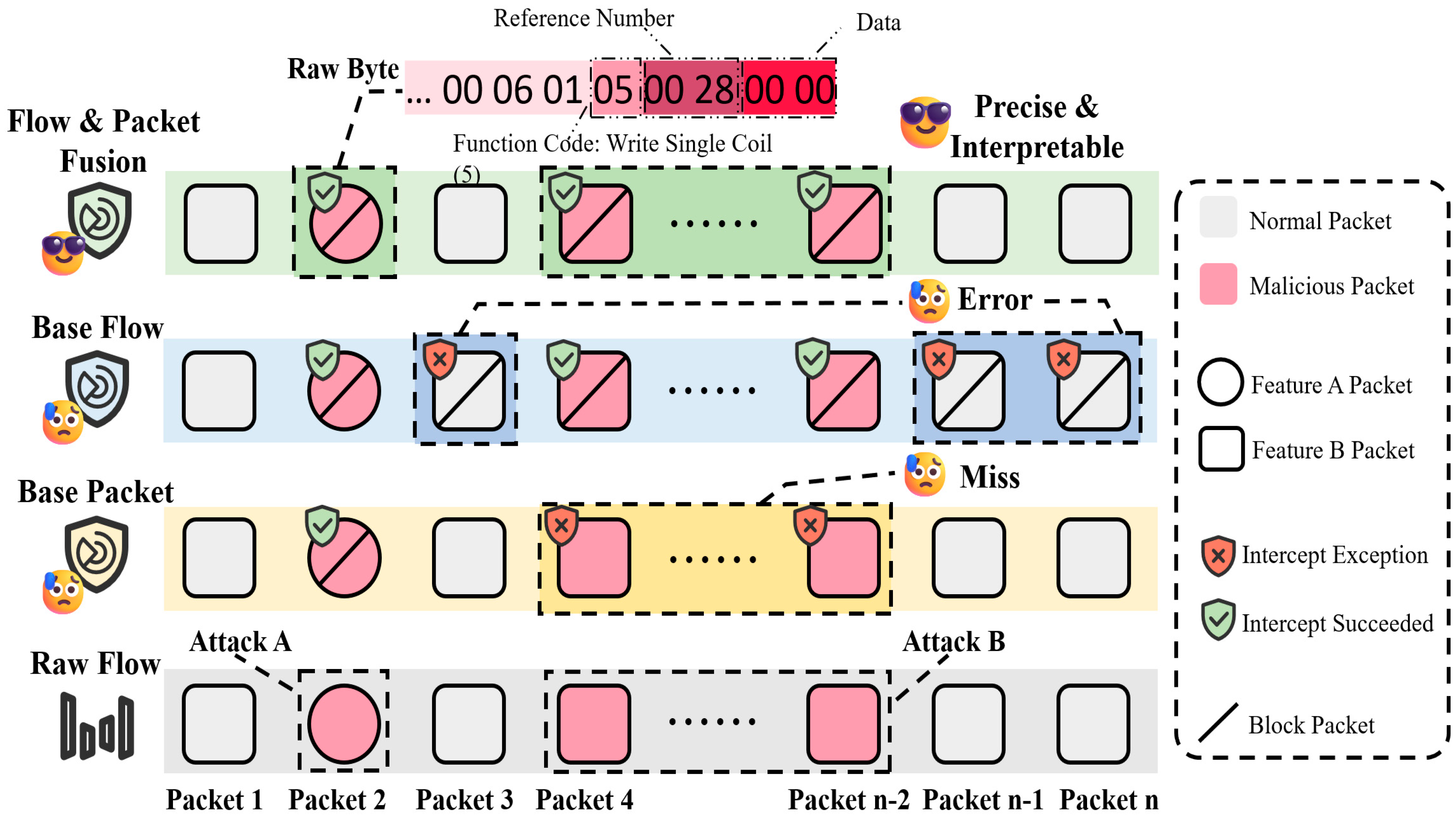

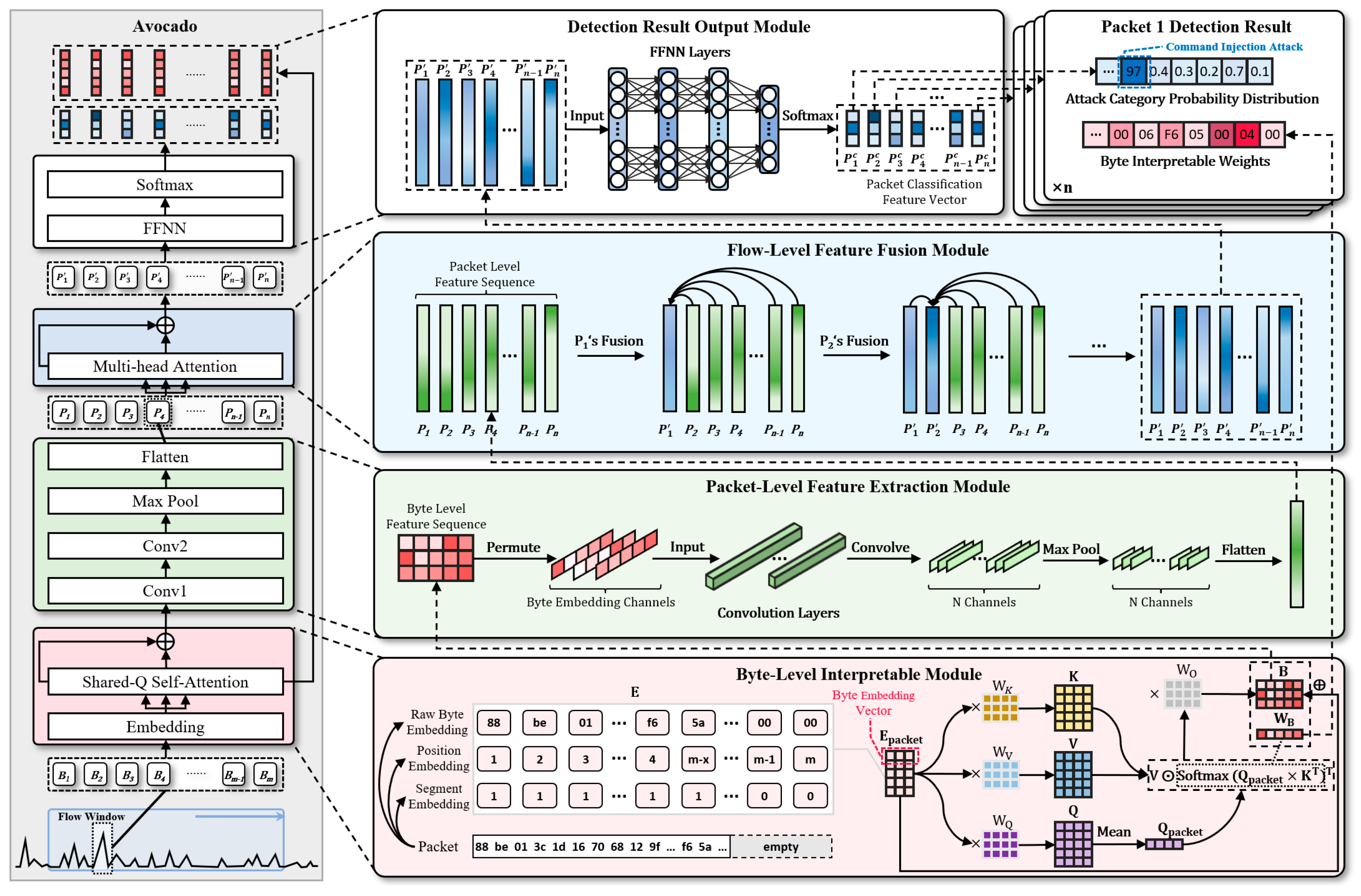
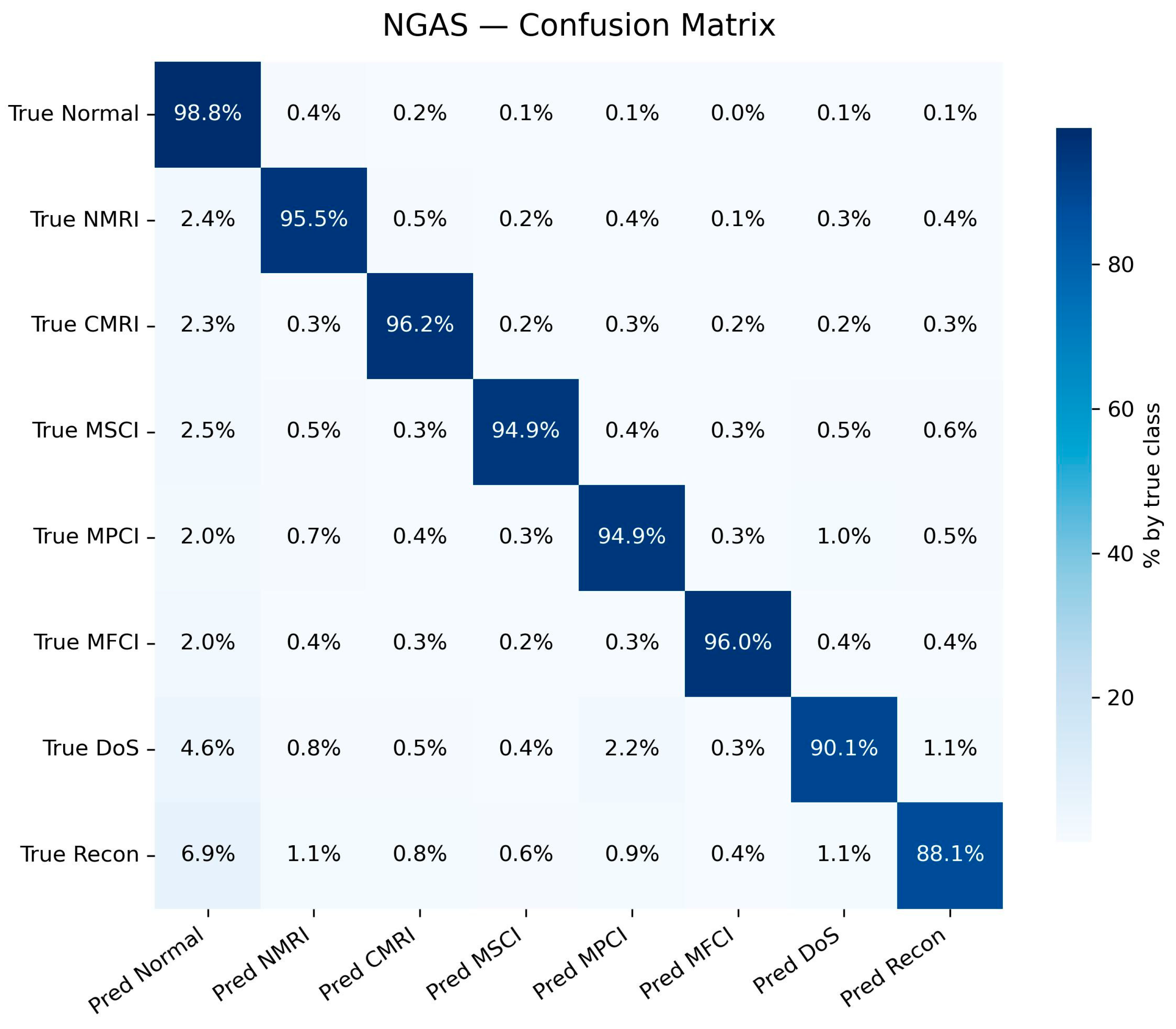
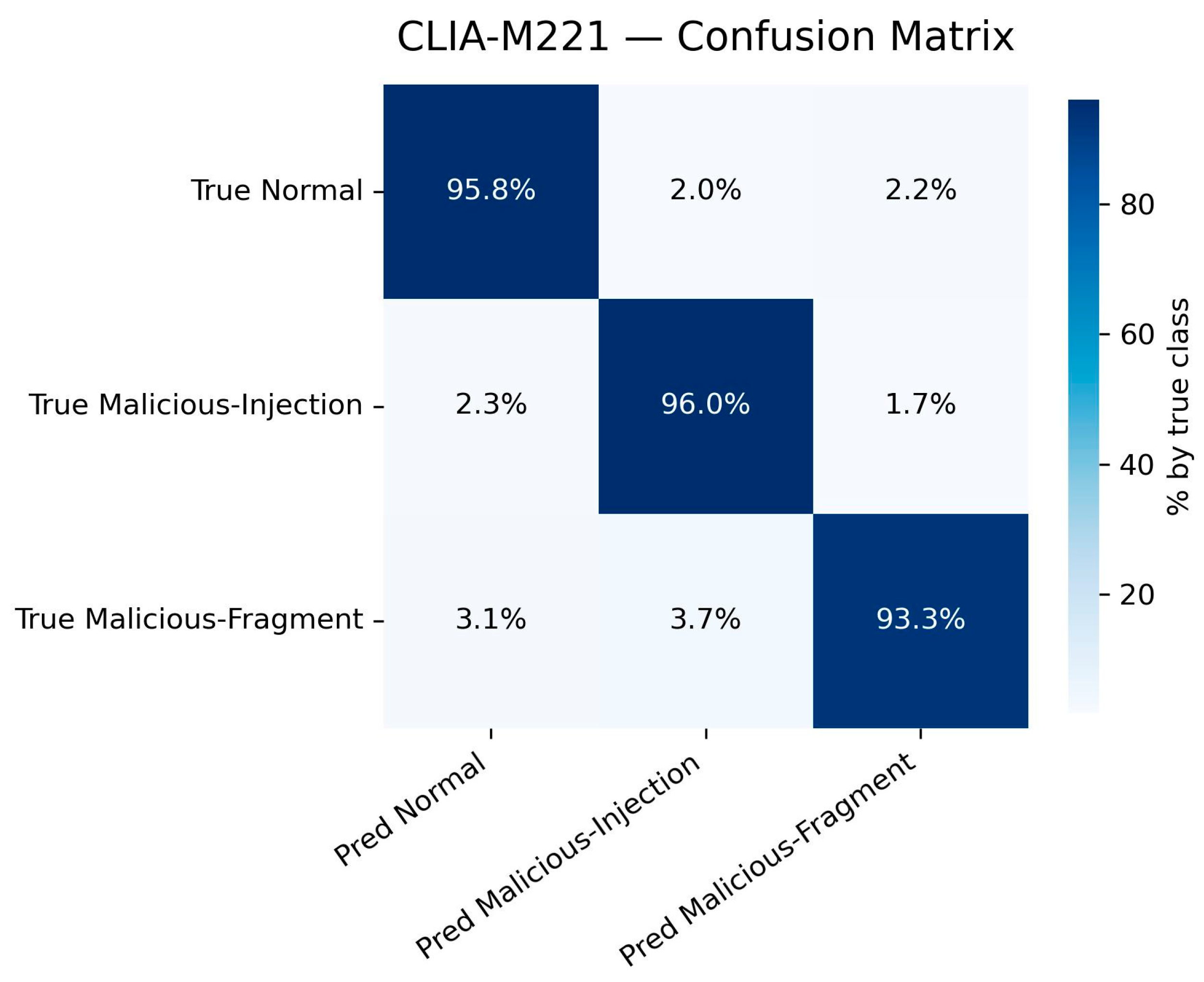

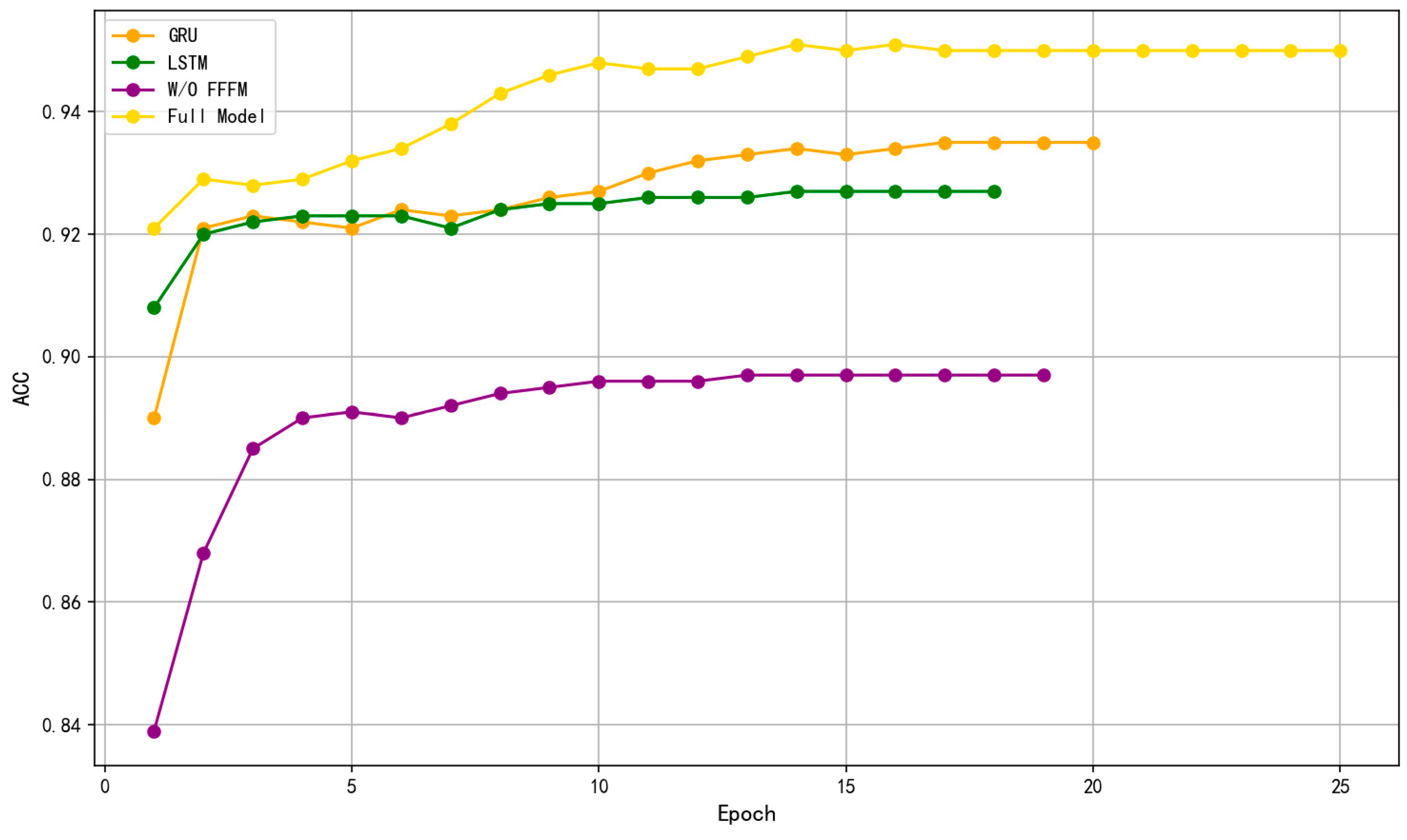
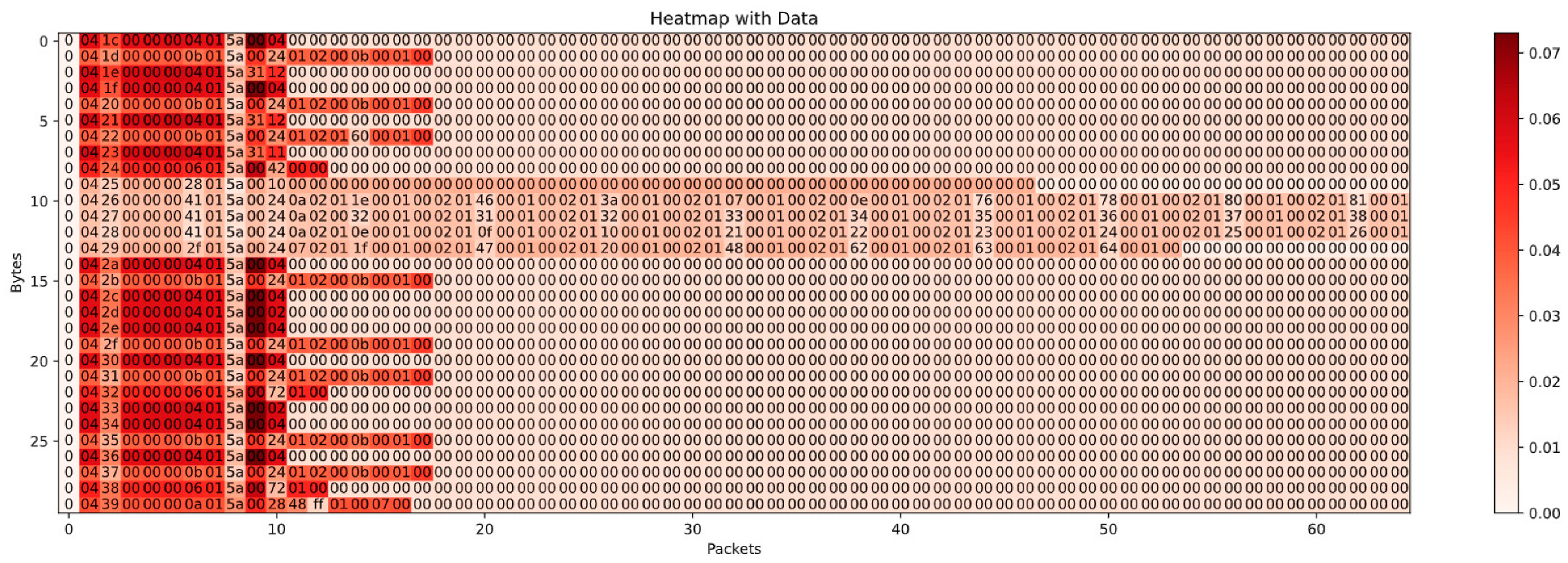
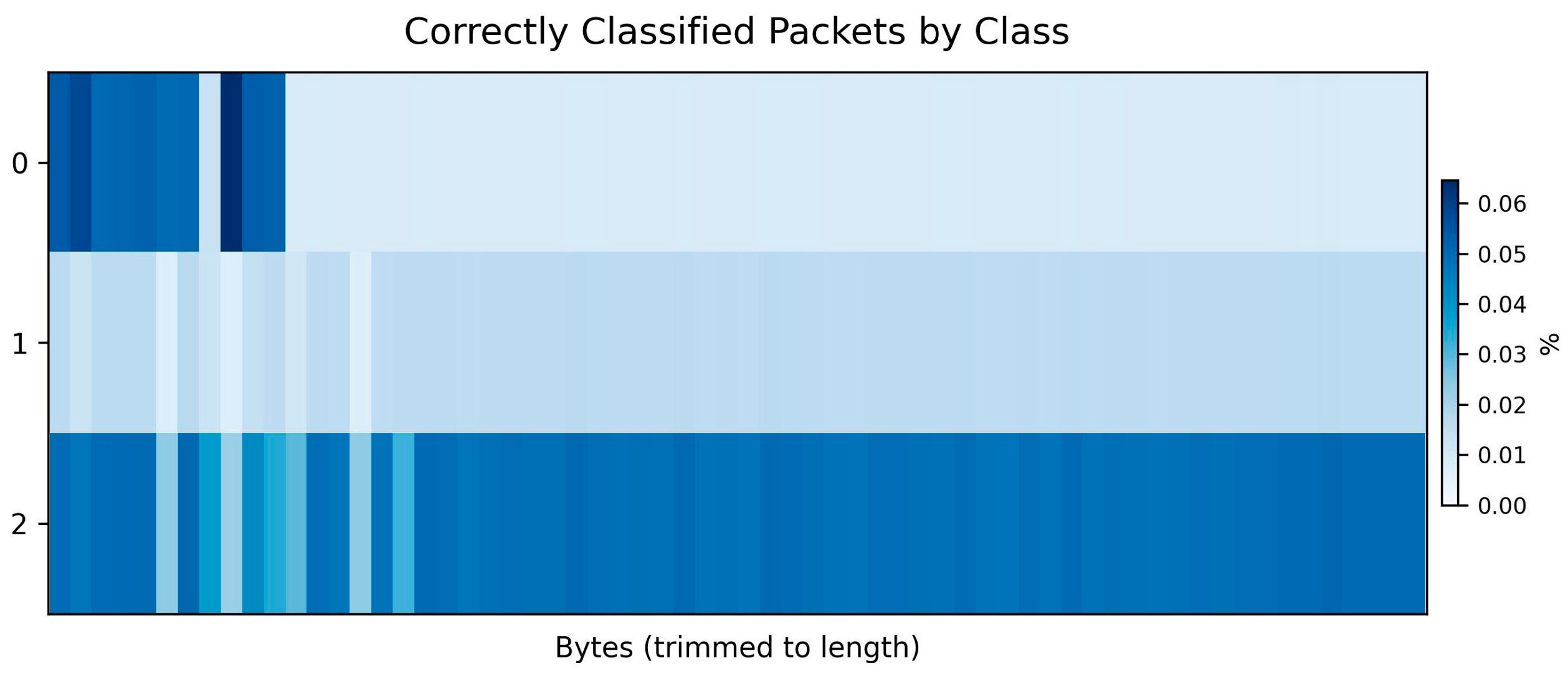
| Attack Types | Network Characteristics | Anomaly Hierarchy |
|---|---|---|
| Reconnaissance [33] | High-frequency scanning; numerous small flows; rapid traversal across IPs/ports | Flow level |
| Denial of Service (DoS) [34] | Bursty traffic; malformed fields (e.g., CRC errors); resource exhaustion patterns | Byte/Packet/Flow level |
| Response Injection [35] | Tampered feedback packets; syntactically valid but semantically inconsistent fields | Byte/Flow level |
| Command Injection [36] | Imitated control commands; structurally similar to normal traffic but with malicious intent | Byte/Packet/Flow level |
| Control Logic Injection [8] | Malicious logic split across multiple packets; delayed or fragmented injection | Byte/Packet/Flow level |
| Parameter | Value | Description |
|---|---|---|
| Random seed | 9876 | Ensures reproducibility of data splits and model initialization |
| Window size (N) | 10 | Number of packets per sliding window |
| Step size (s) | 1 | Window stride between samples |
| Packet length (m) | 128 bytes | Truncated or padded to fixed length |
| Batch size | 128 | Number of samples per iteration |
| Dropout | 0.2 | Regularization factor |
| Optimizer | AdamW | With weight decay = 1 × 10−4 |
| Learning rate | 1 × 10−3 (cosine schedule) | Dynamically adjusted during training |
| Early stopping | patience = 5 | Stops training if no validation improvement |
| Categories | Tags | Size (MB) | Control the Amount of Logic | M221 Number of Packets | Number of Write Request Packets |
|---|---|---|---|---|---|
| Normal control logic is issued | 0 | 2.1 | 22 | 10,148 | 1101 |
| Malicious control logic injection | 1 | 3.7 | 29 | 11,092 | 1535 |
| Malicious Control logic | 2 | 2.2 | 29 | 8168 | 5362 |
| Categories | Tags | Number of Samples |
|---|---|---|
| Normal | 0 | 214,580 |
| NMRI | 1 | 20,412 |
| CMRI | 2 | 13,035 |
| MSCI | 3 | 7900 |
| MPCI | 4 | 7753 |
| MFCI | 5 | 4898 |
| DoS | 6 | 3874 |
| Recon | 7 | 2176 |
| Methods | NGAS [20] | CLIA-M221 [8] | ||||||||||
|---|---|---|---|---|---|---|---|---|---|---|---|---|
| ACC (%) | FPR (%) | FNR (%) | P (%) | R (%) | F1 (%) | ACC (%) | FPR (%) | FNR (%) | P (%) | R (%) | F1 (%) | |
| Osho et al. [11] | 83.6 | 8.3 | 12.5 | 74.7 | 87.5 | 80.7 | 80.4 | 9.1 | 14.7 | 94.7 | 85.3 | 89.6 |
| ASandeep et al. [12] | 88.9 | 5.7 | 8.9 | 81.8 | 91.1 | 86.1 | 86.3 | 7.4 | 9.5 | 95.9 | 90.5 | 93.0 |
| Anton et al. [13] | 92.1 | 5.3 | 4.6 | 83.5 | 95.4 | 89.1 | 90.2 | 6.5 | 7.1 | 96.4 | 92.9 | 94.6 |
| Wang et al. [25] | 91.8 | 4.3 | 5.9 | 85.9 | 94.1 | 89.8 | 90.2 | 5.9 | 7.0 | 96.8 | 93.0 | 94.7 |
| Huda et al. [22] | 93.7 | 4.0 | 6.2 | 86.8 | 93.8 | 90.1 | 92.6 | 5.3 | 6.3 | 97.1 | 93.7 | 95.3 |
| Aouedi et al. [23] | 94.2 | 4.0 | 4.7 | 87.0 | 95.3 | 91.0 | 91.6 | 5.4 | 6.4 | 97.1 | 93.6 | 95.3 |
| Yang et al. [24] | 94.3 | 3.8 | 4.5 | 87.6 | 95.5 | 91.4 | 92.8 | 4.6 | 6.1 | 97.5 | 93.9 | 95.7 |
| Our model | 95.7 | 3.2 | 3.6 | 89.4 | 96.4 | 92.7 | 94.5 | 3.7 | 4.3 | 98.0 | 95.7 | 96.9 |
Disclaimer/Publisher’s Note: The statements, opinions and data contained in all publications are solely those of the individual author(s) and contributor(s) and not of MDPI and/or the editor(s). MDPI and/or the editor(s) disclaim responsibility for any injury to people or property resulting from any ideas, methods, instructions or products referred to in the content. |
© 2025 by the authors. Licensee MDPI, Basel, Switzerland. This article is an open access article distributed under the terms and conditions of the Creative Commons Attribution (CC BY) license (https://creativecommons.org/licenses/by/4.0/).
Share and Cite
Liu, X.; Liu, T.; Hu, N. Avocado: An Interpretable Fine-Grained Intrusion Detection Model for Advanced Industrial Control Network Attacks. Electronics 2025, 14, 4233. https://doi.org/10.3390/electronics14214233
Liu X, Liu T, Hu N. Avocado: An Interpretable Fine-Grained Intrusion Detection Model for Advanced Industrial Control Network Attacks. Electronics. 2025; 14(21):4233. https://doi.org/10.3390/electronics14214233
Chicago/Turabian StyleLiu, Xin, Tao Liu, and Ning Hu. 2025. "Avocado: An Interpretable Fine-Grained Intrusion Detection Model for Advanced Industrial Control Network Attacks" Electronics 14, no. 21: 4233. https://doi.org/10.3390/electronics14214233
APA StyleLiu, X., Liu, T., & Hu, N. (2025). Avocado: An Interpretable Fine-Grained Intrusion Detection Model for Advanced Industrial Control Network Attacks. Electronics, 14(21), 4233. https://doi.org/10.3390/electronics14214233






